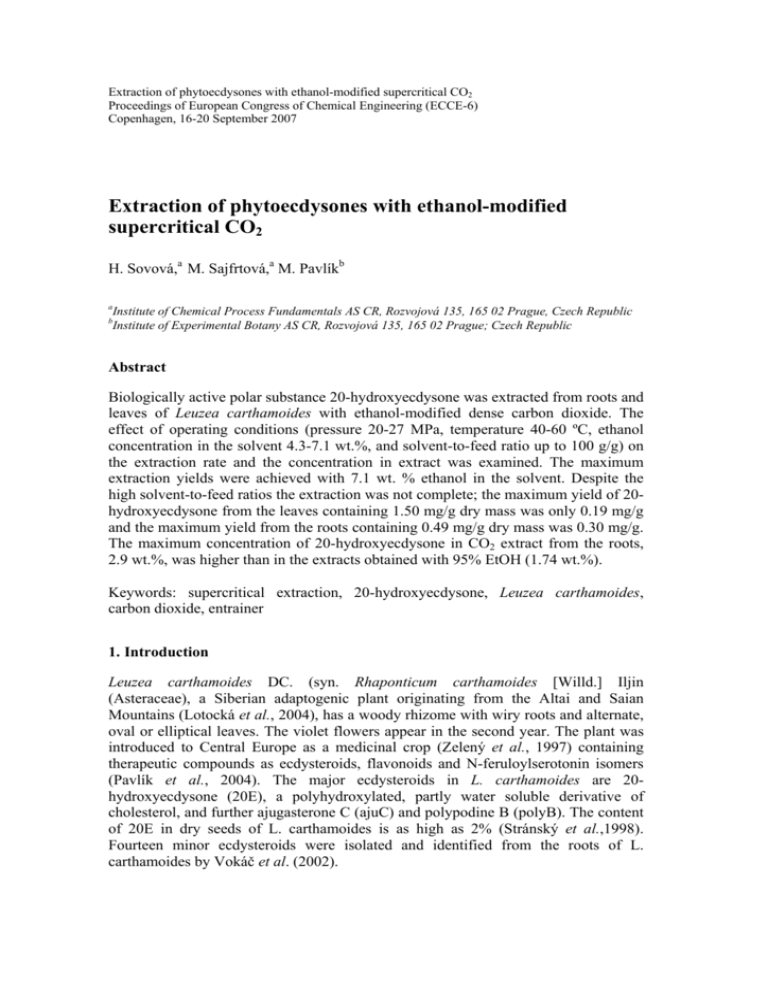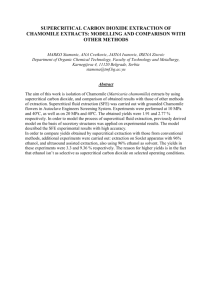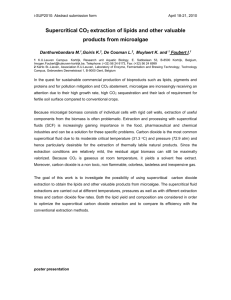full pdf manuscript of the abstract
advertisement

Extraction of phytoecdysones with ethanol-modified supercritical CO2 Proceedings of European Congress of Chemical Engineering (ECCE-6) Copenhagen, 16-20 September 2007 Extraction of phytoecdysones with ethanol-modified supercritical CO2 H. Sovová,a M. Sajfrtová,a M. Pavlíkb a b Institute of Chemical Process Fundamentals AS CR, Rozvojová 135, 165 02 Prague, Czech Republic Institute of Experimental Botany AS CR, Rozvojová 135, 165 02 Prague; Czech Republic Abstract Biologically active polar substance 20-hydroxyecdysone was extracted from roots and leaves of Leuzea carthamoides with ethanol-modified dense carbon dioxide. The effect of operating conditions (pressure 20-27 MPa, temperature 40-60 ºC, ethanol concentration in the solvent 4.3-7.1 wt.%, and solvent-to-feed ratio up to 100 g/g) on the extraction rate and the concentration in extract was examined. The maximum extraction yields were achieved with 7.1 wt. % ethanol in the solvent. Despite the high solvent-to-feed ratios the extraction was not complete; the maximum yield of 20hydroxyecdysone from the leaves containing 1.50 mg/g dry mass was only 0.19 mg/g and the maximum yield from the roots containing 0.49 mg/g dry mass was 0.30 mg/g. The maximum concentration of 20-hydroxyecdysone in CO2 extract from the roots, 2.9 wt.%, was higher than in the extracts obtained with 95% EtOH (1.74 wt.%). Keywords: supercritical extraction, 20-hydroxyecdysone, Leuzea carthamoides, carbon dioxide, entrainer 1. Introduction Leuzea carthamoides DC. (syn. Rhaponticum carthamoides [Willd.] Iljin (Asteraceae), a Siberian adaptogenic plant originating from the Altai and Saian Mountains (Lotocká et al., 2004), has a woody rhizome with wiry roots and alternate, oval or elliptical leaves. The violet flowers appear in the second year. The plant was introduced to Central Europe as a medicinal crop (Zelený et al., 1997) containing therapeutic compounds as ecdysteroids, flavonoids and N-feruloylserotonin isomers (Pavlík et al., 2004). The major ecdysteroids in L. carthamoides are 20hydroxyecdysone (20E), a polyhydroxylated, partly water soluble derivative of cholesterol, and further ajugasterone C (ajuC) and polypodine B (polyB). The content of 20E in dry seeds of L. carthamoides is as high as 2% (Stránský et al.,1998). Fourteen minor ecdysteroids were isolated and identified from the roots of L. carthamoides by Vokáč et al. (2002). H. Sovová Feeding Japanese quails with pulverized seeds of L. carthamoides, Koudela et al. (1995) confirmed previous findings of strong anabolic effects of the plant in growth of the vertebrate animals. Ibatov (1995) applied successfully decoction of the rhizome of the plant in therapy of alcoholic patients. According to clinical tests (Kormosh et al., 2006), combination of ethanol/water extracts from adaptogenic plants (roots of L. carthamoides, Rhodiola rosea, Eleutherococcus senticosus and fruits of Schizandra chinensis) may boost the suppressed immunity in ovarian cancer patients who are subject to chemotherapy. Ethanol extract from L. carthamoideds seeds has a strong repellent effect (Pavela, 2002). 20-Hydroxyecdysone is a hormone that plays a key role in insect development, cell proliferation, growth and apoptosis by controlling gene expression involved in molting and metamorphosis. Calas et al. (2006) examined the effects of 20E purified from L. carthamoides on the European grapevine moth and showed that it is sensed both in larvae and adults where it respectively inhibits feeding and oviposition. Pavela et al. (2005) tested on the cabbage aphid the effects of three ecdysteroid compounds isolated from L. carthamoides, 20E, ajuC and polyB, and found that 20E was less efficient than the other ecdysteroids, what concerns the mortality of larvae and adults. In this work, the feasibility of supercritical fluid extraction of ecdysteroids from L. carthamoides was investigated. Due to the polar character of the extracted substances, ethanol was added to CO2 solvent to increase its polarity. 2. Experimental 2.1. Materials Air dried leaves and roots of L. carthamoides containing 5.8 and 6.1 wt. % of water, respectively, were milled and sieved; the fractions 0.2-0.4 mm size were used in all experiments. Carbon dioxide (> 99.9%) was purchased from Linde Technoplyn (Prague, CR), ethanol for spectroscopy was from Lachema Neratovice (CR). The chromatographic standards 20-hydroxyecdysone was from Sigma-Aldrich (Steinheim, Germany). 2.2. Supercritical extraction The extractor of volume 12.6 cm3 and inner diameter 8 mm contained 1.1-3.5 g of L. carthamoides leaves or roots placed between two layers of glass beads serving as flow distributors. Carbon dioxide from pressure bottle was pumped by a compressor, its pressure was adjusted by a pressure regulator and in a capillary it was mixed with ethanol pumped at constant flow rate by HPLC pump. The capillary was immersed together with the extractor in a thermostated water bath and connected to the extractor outlet. The solution of extracted compounds in the solvent flowed out of the extractor bottom to a heated micrometer valve where it expanded to ambient pressure. The compounds precipitating from gaseous mixture of CO2 and ethanol were trapped in a glass U-tube and the amount of the gas flowing out of the trap was measured by gas meter. The amount of extract in the trap was determined gravimetrically. Three or 2 Extraction of phytoecdysones with ethanol-modified supercritical CO2 four samples of the extract were taken in each experimental run, changing the traps. The extraction conditions were the pressure in the range 20-27 MPa, the temperature 40-60 ºC, the flow rates of CO2 and ethanol 0.52 and 0.-0.037 g/min, respectively. 2.3. Extraction with ethanol A sample (0.5 g of leaves or 1 g of roots) was mixed with 20 ml of 95% ethanol and boiled in water bath for 30 min. After 5 min. precipitation in was filtered through cotton wool, the residue was rinsed 2×3 ml ethanol and thr filtrates were joined. The residuum in the flask was mixed again with 20 ml of 95% ethanol and the procedure was repeated. Joint filtrates were filtered over diatomeous filter, the solution was concentrated, placed in an ampule, and the solvent was removed at 40 ºC by a stream of nitrogen. The ampule was dried in a vacuum desiccator over silica gel for 48 h. 2.4. HPLC analysis The HPLC separation and external standard method were applied for the quantitative determination of 20-hydroxyecsdysone. 3. Results 3.1. Extraction yields of 20-hydroxyecdysterone Yiel of 20E, mg/g dry matter As proved by preliminary experiments, the extraction was equilibrium controlled; the yield was dependent only on the amount of solvent, not on the extraction time. The yield of 20E from the leaves was primarily influenced by ethanol concentration in the solvent (Figures 1, 2). The best results were obtained with 7.1 wt. % ethanol in the solvent at the maximum applied pressure. Even at the best conditions, the extraction of 20E was slow and the experimental runs were finished before the extraction was complete. 0.2 0.15 0 % EtOH 2.9 % EtOH 0.1 4.3 % EtOH 7.1 % EtOH 0.05 0 0 20 40 60 80 Solvent-to-feed, g/g dry matter Fig. 1. Extraction of 20-hydroxyecdysone from the leaves. Extraction pressure and temperature: 25 MPa, 50-60 ºC. 3 H. Sovová Yield of 20E, mg/g dry matter The rate of 20-hydroxyecdysone extraction from the roots was different; very slow extraction followed after a fast initial period, as shown in Figures 2 and 3. Thus, the yield in the end of the initial period was decisive for the final result. This yield increased with increasing ethanol concentration in CO2, pressure and temperature. 0.4 0.3 P=20 MPa P=27 MPa 0.2 P=28 MPa 0.1 0 0 20 40 60 80 100 120 Solvent-to-feed, g/g dry matter Yield of 20E, mg/g dry matter Fig. 2. Extraction of 20-hydroxyecdysone from the roots with 7.1 wt. % ethanol in the solvent at 60 ºC. 0.35 0.3 0.25 50 C, 7.1% EtOH 0.2 60 C, 7.1% EtOH 0.15 50 C, 5.7% EtOH 60 C, 5.7% EtOH 0.1 0.05 0 0 50 100 Solvent-to-feed, g/g dry matter Fig. 3. Extraction of 20-hydroxyecdysone from the roots at the pressure 27 MPa. In terms of the 20E yields, the present results of supercritical extraction are worse than those of the extraction with ethanol. As determined by the extraction with ethanol, the content of 20E in the leaves and roots was 1.5 and 0.49 mg/g dry matter, respectively, while the best results of supercritical extraction are 0.20 and 0.30 mg/g dry matter, respectively. However, the yield of 20-hydroxyecdysone in the supercritical extraction from both leaves and roots increased progressively with the 4 Extraction of phytoecdysones with ethanol-modified supercritical CO2 increase in ethanol concentration in carbon dioxide, and thus substantially higher yields could be expected at higher ethanol concentrations than 7.1 wt. %. 3.2. Concentration of 20-hydroxyecdysone in extracts Generally, one of the expected advantages of supercritical extraction over the extraction with liquid solvents at ambient pressure is higher purity; it is higher concentration of required substances in the extract. In the present experiments the 20E concentration in the extracts obtained with ethanol from the leaves and roots of L. carthamoides were 0.71 and 1.74 wt. %, respectively. In supercritical extraction from the leaves, the amount of total extract was dependent on the concentration of ethanol entrainer much less than the amount of extracted 20E. Besides, most of the total extract was collected at solvent-to-feed ratio less than 12 and then the amount of total extract was increasing only slightly, while the extraction of 20E continued in almost unchanged rate. Its concentration in the extract therefore increased with the yield of 20E, it is with increasing solvent-to-feed ratio and ethanol concentration in the solvent. The best 20E concentration in the extract at the solventto feed ratio equal to 56 was 0.52 wt. %. Again, an increase in the concentration is expected for higher ethanol concentrations in carbon dioxide in future experiments. In supercritical extraction from the roots, the highest concentration of 20E in the extract, 2.95 wt. %, was also obtained for the maximum extraction yield of 20E. 4. Conclusions The supercritical extraction of 20-hydroxyecdysone from L. carthamoides was controlled by phase equilibrium among solute, carbon dioxide, entrainer, and matrix, which was unfavourable for the extraction from leaves but acceptable for the first period of extraction from roots. The yield of 20E from the roots increases with increasing extraction pressure, temperature and content of ethanol in the solvent. The yield of 20E from the roots at optimum extraction conditions (pressure 28 MPa, temperature 60 ºC, ethanol concentration in the solvent 7.1 wt. %) was 0.34 mg/g dry matter, compared to the yield 0.49 mg/g dry matter obtained with ethanol. Its concentration in the supercritical extract, however, was 2.95 wt. %, compared to 1.74 wt. % in the extract with ethanol. Moreover, the extraction yields and 20E concentrations in the extract would further increase at higher ethanol concentrations in CO2 than those applied in this work. Acknowledgements. The authors thank L. Opletal for Leuzea roots and leaves and their extraction with ethanol, M. Koptová for supercritical extraction and M. Bártlová for HPLC analysis. Financial support of the Ministry of Education (project MŠMT 2B06024) and the Grant Agency of the Czech Republic (project No. 104/06/1174) is gratefully acknowledged. 5 H. Sovová References Calas, D., Thiery, D. and Marion-Poll, F., (2006) Journal of Chemical Ecology, 32, 2443-2454. Ibatov, A. N., (1995) Zhurnal nevropatologii i psikhiatrii imeni S. S. Korsakova, 95(4), 78-79. Kormosh, N., Laktionov, K. and Antoshechkina, M., (2006) Phytotheraphy Research, 20, 424-425. Koudela, K., Tenora, J., Bajer, J., Mathová, A. and Sláma, K., (1995) European Journal of Entomology, 92, 349354. Lotocká, B, and Geszprych, A., (2004) Botanical Journal of the Linnean Society, 144, 207-233. Pavela, R., (2002) National Academy Science Letters - India, 25(1-2), 40-42. Pavela, R., Harmatha, J., Barnet, M., Vokáč, K., (2005) European Journal of Entomology, 102, 647-653. Pavlík, M., Pavlíková, D., Szaková, J., Vašíčková, S. and Tlustoš, P., (2004) International Biodeterioration and Biodegradation, 54, 239-243. Stránský, K., Němec, V. and Sláma, K., (1998) Russian Journal of Plant Physiology, 45, 333-338. Vokáč, K., Budešínský, M., Harmatha, J., (2002) Collection of Czechoslovak Chemical Communications, 67, 134139. Zelený, J., Havelka, J. and Sláma, K., (1997) European Journal of Entomology, 94, 183-198. 6





